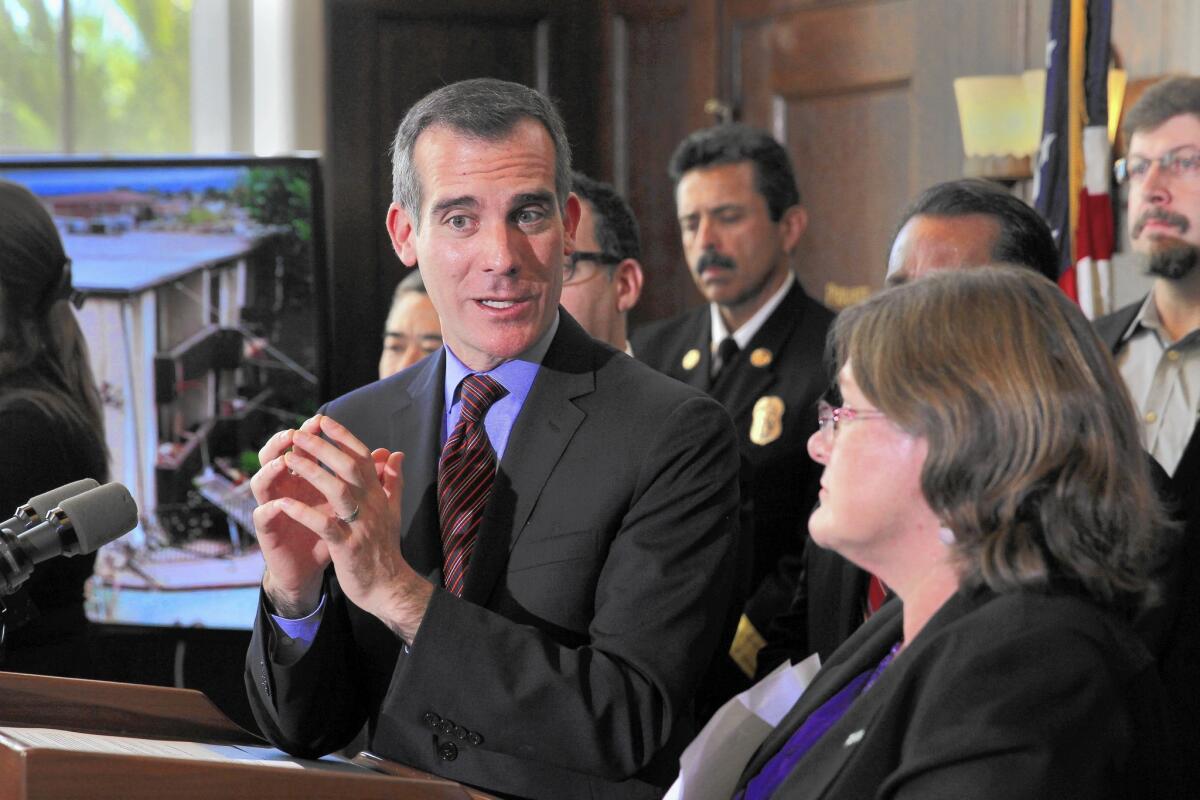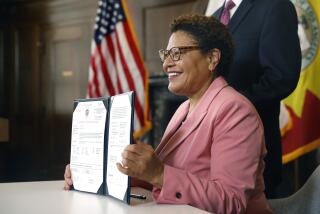Garcetti hopes to have L.A.’s quake retrofit laws in place this year

Los Angeles Mayor Eric Garcetti has set a deadline for his plan to require retrofitting of thousands of earthquake-vulnerable buildings, saying he’d like to have the new laws in place by the end of the year.
It’s an aggressive timeline, compared with how long San Francisco took to pass its landmark earthquake retrofit law. City officials there spent more than a decade researching the problem and developing a plan that finally garnered unanimous support from the San Francisco Board of Supervisors. Garcetti’s proposal is more sweeping than San Francisco’s law, covering more types of buildings.
Since Garcetti proposed in December the most far-reaching seismic safety measures in California history, he has been hopscotching around L.A., pitching the plan to voters at town hall meetings and calling on City Hall to act sooner than later.
“We need to get this done, and we need to get it done now,” Garcetti recently told the Los Angeles Area Chamber of Commerce. “I hope that in the first six months of this year, we will see that move and that we will have in place by year’s end these ordinances.”
Under his plan, wooden buildings would have to be retrofitted within five years after the law is passed; concrete structures would be retrofitted within 30 years.
In L.A. council chambers, city lawmakers have voiced their support for an earthquake strengthening plan. But figuring out how to pay for these costly retrofits has not been easy. The retrofits could cost as much as $130,000 for wooden apartments and millions for taller concrete buildings.
The head of the City Council’s housing committee, Councilman Gil Cedillo, recently pledged that tenants would not face huge rent increases as a result of the earthquake retrofits.
“Our goal is ... to bring as many resources, a menu of resources, to the building owners so that they can comply,” Cedillo recently told The Times.
These options could include low-interest loans and tax breaks to owners who retrofit. Cedillo and his colleagues are also looking into expanding a program that could provide private loans for retrofitting that would be paid back through a temporary, voluntary increase on their property tax bill.
Because the program allows borrowers to pay the loan back through property taxes, instead of to a bank, it lowers costs and allows the loan to remain in place even when a property is sold.
Housing officials have been working with tenant and landlord groups to come up with recommendations on how the retrofit costs could be paid for and shared among renters and owners.
The mayor has voiced confidence that a mandatory law will pass. He credited the work of his office and his earthquake advisor, U.S. Geological Survey seismologist Lucy Jones, for having 130 meetings last year to get feedback from various groups.
The dangers of concrete buildings have been known since the 1971 Sylmar earthquake, when hospital buildings were destroyed. As many as 50 of the more than 1,000 concrete buildings across the city would collapse in a big earthquake, The Times reported in 2013.
Wooden buildings with weak first floors — called “soft-story” buildings and often with carports on the lowest story — are also a well-known risk. Sixteen people were killed when the Northridge Meadows apartment complex pancaked onto the ground floor in the 1994 earthquake. There are as many as 13,000 of these buildings across the city, according to city building officials.
Larger quakes could shut down entire commercial districts if many buildings collapse, which would be economically devastating to the city.
Although the earthquake risk has been long known for concrete and wooden buildings, most California cities have not required retrofits of these types of structures. A few years after the Northridge earthquake, Los Angeles elected officials shelved proposals for mandatory retrofits and opted for voluntary retrofits instead.
San Francisco city officials in 1998 began a far-reaching study to identify quake vulnerabilities too, but political pressure ended up shelving that study as well. Gavin Newsom began championing the issue as mayor, and his successor, Ed Lee, pushed through a mandatory quake-retrofit law for large wooden soft-story apartment buildings that passed in 2013. It was one of the first cities in California to pass such a retrofit law for wooden apartment buildings.
Garcetti’s plan goes further than San Francisco’s — asking for mandatory retrofitting of concrete buildings. San Francisco so far has not addressed concrete buildings, a problem that has been more complicated and politically difficult to tackle. A San Francisco city report issued a few years ago called for residential concrete buildings to be retrofitted between 2020 and 2031, but the Board of Supervisors would have to pass a new ordinance to deal with that issue.
Garcetti’s proposal for Los Angeles would require retrofits for seismically weak wood-frame residential and commercial buildings with two or more stories built before 1980. Single-family homes, duplexes and triplexes would be exempted.
His plan would give owners of concrete buildings built before 1980 five years to complete a seismic evaluation after receiving an order from the city. At-risk buildings would have 25 more years to retrofit. Single-family dwellings would be exempted.
Garcetti said he was not willing to compromise on the law being mandatory and would only be flexible in speeding up the retrofit deadline, not relaxing it.
“I imagined what it would be like long after I was mayor, to be living here with my family, and the Big One hit,” Garcetti said in a recent interview. “I didn’t want to look back and say, ‘I should’ve made it mandatory.’”
More to Read
Start your day right
Sign up for Essential California for news, features and recommendations from the L.A. Times and beyond in your inbox six days a week.
You may occasionally receive promotional content from the Los Angeles Times.








